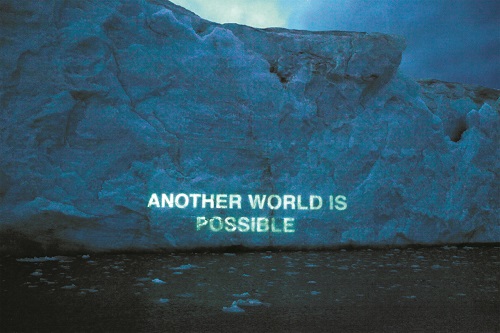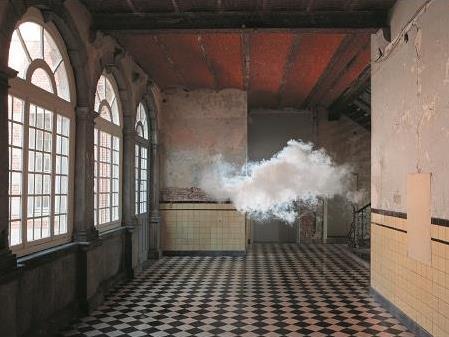Berndnaut Smilde, Nimbus D’Aspremont, 2012, digital C-type print, 75 x 110 cm. Courtesy of the artist and Ronchini Gallery, London. Image supplied.
On balance, museums and galleries within Australia, while happy to support the artist to use the museum as a platform to espouse their own ideas around gender, sexuality, ethnicity, the environment, or local and global politics, seem rather unwilling to initiate or present these agendas themselves, remaining instead within the known, accepted and uncontroversial frameworks of the thematic survey or retrospective exhibition.
Perhaps one of the most subtle and interesting things about ART+CLIMATE=CHANGE—and we can potentially determine this from a glance at the list of organisations that participated—is the manner in which its very clear purpose serves as a provocation to the art museum itself, challenging those of us who work within them to interrogate the expectations we have (or parameters we place) around the work we show and the way we communicate with our audiences, while similarly highlighting the seeming rarity of art exhibitions in which a particular stand or point of view is made, owned and clearly expressed.
So, ART+CLIMATE=CHANGE presents a number of important questions around curatorial practice back to its constituents: those employed in the visual arts as curators, programmers and producers. Why are we afraid, for example, to engage in and encourage debate within our work of exhibition-making and to effectively, and bravely, put our heads above the parapet when needed?
Importantly, the ART+CLIMATE=CHANGE festival has given those involved the opportunity to speak collectively about the most pressing issue facing twenty-first-century society: to voice concerns, provide alternative ways for looking at and addressing current issues, and to make a contribution that both anticipates and encourages unexpected outcomes and new ways of being in our world. Above all, ART+CLIMATE=CHANGE demonstrates a sense of hope and faith in the experience of art to communicate meaningfully, and a belief that art, and exhibitions, can function as powerful catalysts of change.
As the work of artists such as Hans Haacke and Fred Wilson cogently demonstrated in the 1970s and 1980s, the museum is not and has never been a neutral or objective space, and to effectively hide behind this sense of neutrality in order to avoid having and communicating an opinion is disingenuous. Power and control play out to varying degrees behind every institution’s walls, and the constant pressure to fundraise and to attract ever larger audiences (whose numbers in turn appeal to corporate sponsors eager to tap these markets) invariably informs the decisions behind who and what is shown and collected, and the narratives that are deemed worthy and appropriate for visitors.
As the blog of the Center for the Future of Museums has recently highlighted, tackling the issues around climate change in exhibition programming, or any politically charged material for that matter, can be difficult terrain to navigate: ‘Many of our colleagues in the museum sector have noted that institutional policy protects sponsors from influencing either administration or programming. We are told that funding is only accepted on the condition that there are no strings attached. Strings, however, need not be visible to make an impact, and self-censorship—however invisible or unquantifiable—is a major factor in every institutional decision. Nobel laureate Eric Chivian recently put it this way: ‘It is just human nature not to bite the hand that feeds you.’ Sponsorships do have an effect at every level, and when a sponsor is known for his anti-science practices, that sponsor circumscribes the very horizon of the possible, not through coercion, but through the invisible threat of withdrawal.’

David Buckland, Another World Is Possible, Ice Texts, 2010, digitally printed photograph, 116 x 79.5 cm. Courtesy of the artist. Image supplied.
While the stakes are perhaps not so high for the majority of participating venues in ART+CLIMATE=CHANGE, their commitment to communicating the issues around cli- mate change is, one can speculate, largely based in the notion of ‘public good’, the bedrock on which great nineteenth-century institutions such as the National Gallery, London, or the Victoria and Albert Museum were founded, and of which we today are the inheritors. On behalf of that sense of ‘public good’, do we have a responsibility to communicate one of the most pressing global challenges facing humankind for future generations? The museums and galleries that presented the twenty-nine exhibitions and events comprising the 2015 ART+CLIMATE=CHANGE festival together answer, through their programming, a resounding ‘yes’.
While ART+CLIMATE=CHANGE has enabled museums and art galleries to reflect on the type of projects they produce, support and present, it is hoped that its multivalent messages around the urgency of climate change equally encourages institutions to reflect on their day-to-day practices with regards to sustainability. Carefully calibrated temperature and humidity control make for an energy-hungry beast, just as the voracious use of materials such as medium-density fibreboard in exhibition design and the ongoing challenge of the storage of these components, which leads to a practice of disposal rather than re-use, and a final resting place as landfill, ensures that museums and galleries are far from exemplars of sustainability best practice. We certainly have a way to go. While the mandate of care and preservation will not change for collecting institutions, museums are beginning to reflect upon their environmental impact and to adapt the management of their resources, their decision-making processes and their policy development accordingly. Change on this front may be incremental, but our valued and trusted role within the community provides other opportunities. As this, the inaugural year of ART+CLIMATE=CHANGE has demonstrated, the work of contemporary artists, together with astute curatorial approaches, can pro- vide multi-layered, open-ended and often speculative approaches that don’t necessarily aim to provide definitive answers, but that can instead bring audiences with them, encouraging a sense of new possibilities, and of hope for and movement towards change.
This article is an extract from ART+CLIMATE=CHANGE edited by Guy Abrahams, Bronwyn Johnson & Kelly Gellatly (MUP $55), available now from https://www.mup.com.au/





